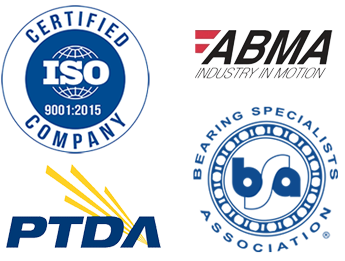From the foundry to the rolling mills, manufacturing steel takes a variety of processes, in very harsh and extreme conditions. Equipment involved in these processes need to withstand severe temperature fluctuations and the intrusion of contaminants, dust, steam, water, and other pollutants. Their components, such as roller bearings, need to operate in that harsh production environment and still offer high precision and reliability.
Bearings play a crucial role in the steel industry as they are responsible for facilitating smooth and efficient operations in various applications. They provide support and reduce friction between moving parts, enabling the movement of heavy loads, machinery, and equipment.
- Reducing Friction: Bearings help in minimizing friction between rotating or moving parts in steel mills, such as rolling mills, conveyors, and cranes. By reducing friction, they prevent excessive wear and tear, decrease energy consumption, and improve overall efficiency.
- Load Support: Steel mills handle heavy loads, and bearings provide essential support to bear the weight and distribute it evenly. They enhance the structural integrity of equipment and prevent damage or failure due to excessive stress.
- Precision and Accuracy: Bearings aid in maintaining precise alignment and positioning of components in steel machinery. They ensure accurate movement, alignment, and synchronization of parts, enabling efficient manufacturing processes and high-quality steel products.
- Durability and Reliability: The harsh operating conditions in the steel industry, such as extreme temperatures, heavy loads, and contaminants, demand robust and reliable bearings. They are designed to withstand these challenging environments and provide long service life, reducing downtime and maintenance costs.
- Safety: Bearings contribute to the safety of steel mill operations by ensuring the smooth and controlled movement of equipment. Properly functioning bearings minimize the risk of sudden failures, malfunctions, and accidents, protecting workers and equipment.
In a new Series of Industry Spotlights, BDS and BMC will take a deeper look into each industry, how bearings play a critical role and how the products and services we provide can keep your customers up and running.
STEEL INDUSTRY: Large Bore Bearings
Engineered to handle heavy radial and axial loads, as well as tilting forces, they are commonly used in heavy-duty industrial machinery that operate under demanding conditions, such as the steel industry. Large bore bearings are rolling element bearings specifically designed to accommodate large shaft diameters that typically exceed 100 mm and can range up to several meters in some industrial applications.
Large Bore Bearing Features
- Size: Large bore bearings are characterized by their significant inner diameter, enabling them to support the weight and loads exerted by heavy machinery components and are designed to provide durability and reliability.
- Rolling Elements: Large bore bearings typically use rolling elements such as cylindrical rollers, spherical rollers, or tapered rollers to distribute the load evenly, reducing friction and enabling smooth rotation.
- Cage Design: Large bore bearings often incorporate cages to separate and guide the rolling elements, ensuring proper spacing and reducing friction. The cage material can be made of steel, brass, or other materials suitable for operating conditions.
- Lubrication: Bearing are designed with lubrication channels or systems to ensure a continuous supply of lubricant, which reduces friction, dissipates heat, and prevents premature wear.
- Sealing: Large bore bearings may feature seals or shields to protect the internal components from contamination, moisture, and debris.
- Mounting and Installation: This type of bearing often requires specialized mounting and installation procedures due to their size and weight, which is essential to ensure optimal performance and prevent premature failure.
Designed to withstand high loads, extreme temperatures, and harsh operating conditions typically encountered in steel mills and foundries, large bore bearings are a crucial component in the following types of equipment:
Rolling Mills: Large bore bearings are used in the rolling mill stands to support the heavy work rolls and backup rolls, which apply pressure and reduce the thickness of the steel and must withstand significant radial and axial loads while maintaining precision and reliability.
Continuous Casting Machines: In the continuous casting process, these bearings must tolerate high temperatures, heavy loads, and potential misalignments during the continuous casting process.
Cranes and Hoists: Large bore bearings are crucial for the smooth rotation of crane hooks, trolleys, and slewing rings, enabling precise and efficient material handling operations.
Steelmaking Furnaces: Bearings are utilized in the steelmaking process, specifically in equipment like ladle turrets and tilting mechanisms furnaces, enduring extreme temperatures, heavy loads, and potentially corrosive environments.
Heavy-duty Conveyors: Large bore bearings are installed in conveyor rollers and pulleys, ensuring smooth rotation, and facilitating the efficient transport of steel coils, plates, and other products.
Forging Presses: Bearings are employed in the press frames and hydraulic systems, facilitating precise movement and force distribution during the forging process.
STEEL INDUSTRY – Tapered Roller Bearings
Tapered Roller Bearings play a crucial role in the production of steel by providing support and facilitating smooth movement in various heavy machinery and equipment. Here's how they are used in steel production:
Tapered roller bearings are extensively used in rolling mills, which are essential in the steel manufacturing process. Rolling mills are responsible for shaping and forming metal into various products, such as sheets, bars, and rails. These bearings support the heavy loads and high speeds involved in the rolling process, allowing the rolls to rotate smoothly.
Steel production involves a range of equipment, including blast furnaces, converters, ladles, and continuous casting machines. Tapered roller bearings are employed in the critical components of this machinery to ensure proper functioning. For example, they are used in the rollers, gears, and shafts of continuous casting machines, which convert molten steel into solidified products.
Conveyor systems are extensively used in steel plants to transport raw materials, semi-finished products, and finished steel. Tapered roller bearings are employed in conveyor rollers to support the load and enable smooth movement along the conveyor belts. These bearings help minimize friction and ensure efficient material handling throughout the production process.
Steel production facilities employ cranes and hoists for various tasks, such as moving heavy steel coils, lifting molten metal, and transporting materials within the plant. Tapered roller bearings are used in the rotating components of cranes and hoists, such as the drum and sheaves, to provide support and enable smooth movement while handling heavy loads.
Tapered roller bearings are also utilized in power transmission equipment employed in steel plants, such as gearboxes and reducers. These bearings help transmit rotational motion and torque efficiently, ensuring reliable operation and minimal energy loss.
Overall, tapered roller bearings are critical components in the steel production process, supporting heavy loads, facilitating smooth movement, and contributing to the efficiency and reliability of various machinery and equipment used in the industry.
STEEL INDUSTRY - Spacers
Spacers in tapered roller bearings contribute to downtime reduction by providing precise axial adjustment, controlling preload, managing temperatures, and facilitating efficient maintenance.
Axial adjustment: Tapered roller bearings often require axial adjustment to achieve optimal performance. Spacers are used to precisely set the axial clearance between the rollers and the bearing raceways. By selecting the appropriate spacer thickness, the axial clearance can be adjusted to ensure proper bearing operation. This adjustment helps prevent excessive heat generation, premature wear, and potential bearing failure, which can lead to unplanned downtime.
Preload control: Tapered roller bearings can benefit from preload, which is the controlled axial force applied to the bearings. Preload eliminates internal clearances and enhances stiffness, resulting in improved bearing rigidity and reduced vibration. Spacers are used to set the desired preload, ensuring the proper distribution of loads within the bearing assembly. By achieving the correct preload, spacers help prevent excessive axial movement, which can lead to decreased bearing life and unexpected downtime.
Temperature management: Tapered roller bearings are subjected to high operating temperatures due to the friction generated during rotation. Spacers contribute to efficient temperature management by aiding in the proper distribution of heat within the bearing assembly. They help maintain the appropriate spacing between the rollers, promoting effective lubrication and heat dissipation. By preventing excessive heat buildup, spacers help extend bearing life, minimize the risk of thermal damage, and reduce the likelihood of unplanned downtime.
Easy replacement and maintenance: Spacers also facilitate easy replacement and maintenance of tapered roller bearings. When maintenance or replacement of bearings is required, spacers can be easily removed and reinstalled, allowing for swift access to the bearing components. This quick and convenient process reduces the overall downtime associated with bearing maintenance, enabling faster equipment turnaround.
STEEL INDUSTRY – Bearing Chock Repairs
In the steel industry, bearing chocks are specialized components used to support and position bearings in heavy machinery, such as rolling mills, continuous casting machines, or other equipment involved in steel production processes. Bearing chocks provide stability and alignment for the bearings, ensuring smooth and efficient operation of the machinery.
Over time, bearing chocks can experience wear and tear due to the high loads, vibrations, and harsh operating conditions present in the steel industry. When bearing chocks require repairs, it typically involves the following steps:
1. Inspection: The damaged bearing chocks are thoroughly examined to assess the extent of the problem. This inspection may involve visual examination, measurements, and non-destructive testing techniques to identify any cracks, deformations, or other issues.2. Removal: The damaged bearing chocks are carefully removed from the machinery, ensuring that all connections, fasteners, and related components are properly detached.
3. Cleaning and preparation: The bearing chocks are cleaned to remove dirt, grease, and any other contaminants. Surface preparation may involve removing rust, scale, or corrosion to ensure proper adhesion during subsequent repair processes.
4. Repair techniques: The specific repair techniques for bearing chocks can vary depending on the nature and extent of the damage. Common repair methods include:
- Additive manufacturing: Some damage or repair types require material to be added. Skilled operators use appropriate equipment, processes, and materials to restore the integrity and center line to blocks and chocks.
- Machining/Grinding In cases where the bearing chocks have worn out or suffered dimensional inaccuracies, machining processes are employed to restore their original dimensions. This may involve turning, milling, grinding, or other machining operations.
- Coating and surface treatment: Protective coatings or surface treatments may be applied to prevent corrosion, improve wear resistance, or provide better lubrication properties. This can extend the service life of the repaired bearing chocks.
5. Reinstallation: Once the repairs are completed, the bearing chocks are reinstalled in the machinery, ensuring proper alignment and adjustment. All connections and fasteners are tightened according to manufacturer specifications.
Keeping the titan of industrial manufacturing running takes hundreds of different types of equipment and bearings are critical to their precision, durability, and safety. From our extensive inventory to our expert modification and repairs services, BDS and BMC have the resources to find a bearing solution that is right for your steel industry customers. To learn more, contact one of our sales professionals and see what we can do for you.
Sources:
- SKF. (2020). Bearings in the Steel Industry. Retrieved from https://www.skf.com/group/industry-solutions/metals/steel-production/bearings-in-the-steel-industry
- NSK. (n.d.). Bearings for the Steel Industry. Retrieved from https://www.nskeurope.com/en/industry-solutions/metals/steel-industry/bearings-for-steel-industry.html
- Schaeffler Group. (n.d.). Bearings in the Steel Industry. Retrieved from https://www.schaeffler.co.uk/content.schaeffler.co.uk/en/branches/industry/steel/bearingssteelindustry/bearingssteelindustry.jsp
- NTN Bearing Corporation. (n.d.). Bearings for Steel Industry. Retrieved from https://www.ntnamericas.com/en/industry-solutions/metals/steel/
- Rollway Bearings. (n.d.). Bearings for Steel Industry. Retrieved from https://www.rollway.com/industries/steel




